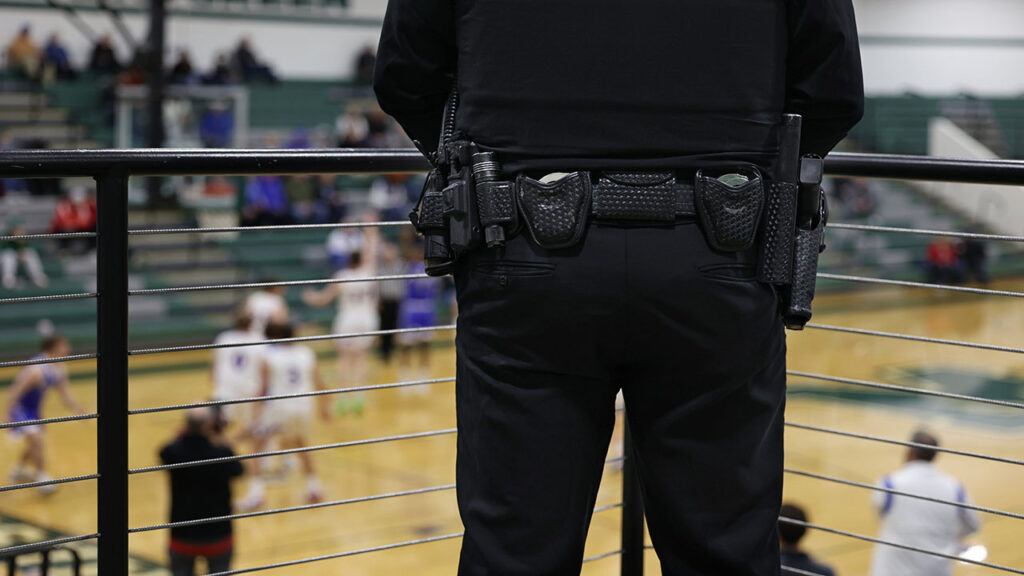
A State Mandated School Threat Assessment. Here’s What It Meant for Students
An analysis of a year of Florida school threat assessment data shows that the practice, designed to intervene before students act on threatening behavior, has been “widely, but not uniformly, successful,” researchers from the University of Virginia found.
The research, funded by the U.S. Department of Justice, relies on a review of reports of more than 23,000 student threat assessments educators conducted in Florida schools during the 2021-2022 academic year. It is the largest, most comprehensive analysis of school-based threat assessment to date, its authors said.
Threat assessment is a formal process through which a team of educators, student support personnel, and school administrators analyze reports of threatening student behavior, determine their severity, and set a plan in place to respond. For example, a student may receive counseling to prevent self-harm.
Students carried out about 6 percent of the threats reported in the data, demonstrating that formal threat assessment protocols can help school staff intervene effectively, said Dewey Cornell, a professor of education at the University of Virginia who co-authored the report and who has helped pioneer the concept of school-based threat assessment.
A very small number of overall threats—.23 percent—resulted in serious injuries. Ninety percent of students who underwent threat assessment remained at their original schools, while the rest withdrew, were transferred to alternative settings, or continued learning online.
“What we found in Florida is that, on a very large scale, we got good results,” Cornell said. “What we hope to show in our future studies are the factors associated with good quality outcomes.”
Here are five key findings from the analysis.
1. States and districts need better data to ensure threat assessment is used fairly and consistently
As more schools adopt threat assessment procedures, they need to collect data to ensure teams are fair and consistent in what they deem a threat and how they respond, said Cornell, a forensic psychologist who has been active in the discussion since the response to the 1999 shooting at Columbine High School in Littleton, Colo.
“They need to have data on how many assessments they do, who are they done with, what are the outcomes, and to look at outcomes across different demographic groups,” he said. “That will allow you to identify and correct problems. If you don’t collect data on outcomes, you are not going to be able to have quality control and improvement.”
The University of Virginia researchers’ findings come as more districts, and many states, have moved to require formal threat assessment processes following mass school shootings that have stoked public concern.
Nine states—Florida, Kentucky, Maryland, Ohio, Pennsylvania, Rhode Island, Texas, Virginia, and Washington state—require schools to have threat assessment teams, according to an analysis by Everytown, an organization that advocates for firearms safety. Those laws vary; some states do not require a specific model of threat assessment, and some do little to monitor compliance.
That can lead to inconsistencies between schools and districts.
“The good news is that more and more states are requiring or encouraging their schools to use threat assessment,” Cornell said. “The bad news is that many states are not adequately funding their mandates and they are not monitoring the quality of training and implementation. It is going to take a concerted effort over a period of years for states to achieve a consistently high level of quality across schools.”
Florida, for example, passed a law following the 2018 mass shooting at Marjory Stoneman Douglas High School in Parkland requiring the process. In the year of data the researchers reviewed, schools were mandated to use a threat assessment protocol developed by Cornell.
But some schools hadn’t fully trained staff in the model by the time researchers collected their data, which was collected voluntarily. Seven of Florida’s 67 school systems did not provide any information to researchers. Schools also varied in the information they kept about if, and how, students were disciplined after a threat assessment was completed.
When analyzing those factors, researchers reviewed available data from districts that provided it.
Texas civil rights advocates have expressed similar concerns about data collected on a new threat assessment requirement there. While such groups have supported threat assessment as an alternative to zero-tolerance discipline, careful monitoring is necessary to ensure students in certain demographic groups aren’t consistently deemed more threatening than others, they said.
2. Most student threats were deemed “transient”
For imminent threats, like when a student is on the way to school with a gun, educators must intervene immediately by contacting law enforcement.
Threat assessment procedures seek to bring data and research to the table when educators determine how to respond to other threatening behavior or messages. When completing an assessment, a trained, designated team must determine if a threat is substantive, requiring more immediate attention, or if it is less severe.
In their analysis of Florida cases, researchers found that 18 percent were deemed “no threat” and the majority, 64 percent, were labeled “transient,” which means educators determined students had no serious intent to act.
“These findings demonstrate the value of using threat assessment to resolve less serious cases efficiently and concentrate more time and effort on serious cases,” the report said. “In contrast, schools relying on a zero-tolerance approach would be removing far more students from school.”
3. Counseling, parent meetings are common responses to threats
More than 73 percent of students were referred for at least one service following an assessment, the analysis found.
Among the most common responses: 45 percent of cases resulted in plans to meet with parents and 33 percent resulted in referrals to mental health services. Not all districts provided information about whether students eventually received recommended services.
4. Researchers detected disparities by students’ race, disability status
Researchers detected racial disparities in which students were referred for threat assessments.
While Black students made up about 21 percent of enrollment in the studied districts, they counted for about 37 percent of students referred for threat assessments. White students, by contrast, made up 35 percent of enrollment and 37 percent of referrals. Hispanic students made up 36 percent of the enrolled population and counted for 23 percent of referrals.
It’s not yet clear whether those disparities are driven by biases among those reporting threats, inconsistent use of threat assessment procedures, or actual differences in student behavior, the researchers wrote. Referrals for threat assessment can be made by a variety of people, including students, staff, and parents, which could lead to some variability.
About 55 percent of students who underwent threat assessments later faced disciplinary consequences, most commonly suspensions. Researchers also detected racial and ethnic disparities in the discipline data, though those statistical gaps were not as pronounced as discipline disparities in schools as a whole. Disciplinary decisions aren’t made by threat assessment teams, but threat assessments can inform decisions of school administrators who act separately, the researchers wrote.
The analysis found that Black and Hispanic students were more likely to face a school placement change or suspension than their white peers after a threat assessment. But such disparities were not found when students faced arrest or citation from law enforcement.
Researchers found that students with disabilities appeared to be more likely than their peers to be referred for threat assessment, but they were less likely to face discipline as a result. But, while districts provided data on students with Individualized Education Programs, they provided less complete information about students with Section 504 plans.
5. Further research is forthcoming
Researchers plan further study on differences in who reports threats and what behavior they report; what threats teams determine to be credible or worthy of intervention; and academic and behavioral outcomes for students who are the subject of threat assessments, Cornell said.
Cornell said it’s a hopeful finding that a very small number of students were referred to law enforcement as a result of threat assessment—less than a percent were arrested and less than 2 percent faced criminal charges.
School administrators are motivated to carry out threat assessment, but they have limited time and resources and lots of competing demands for their attention, Cornell said. As states scale up the approach, they should address those concerns and monitor how their mandates are carried out in schools, he said.
“It’s the reality that when you want to implement change, you can’t just wave a wand and have it happen,” Cornell said.
Dig Deeper With Our Longreads
Newsletter Sign up to get our best longform features, investigations, and thought-provoking essays, in your inbox every Sunday.
The MEN was founded by John Huber in the fall of 2020. It was founded to provide a platform for expert opinion and commentary on current issues that directly or indirectly affect education. All opinions are valued and accepted providing they are expressed in a professional manner. The Maryland Education Network consists of Blogs, Videos, and other interaction among the K-12 community.











